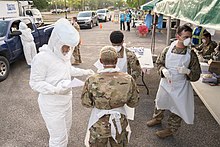| COVID-19 pandemic in Louisiana | |
|---|---|
 A testing site in New Orleans | |
| Disease | COVID-19 |
| Virus strain | SARS-CoV-2 |
| Location | Louisiana, U.S. |
| Index case | Orleans Parish |
| Arrival date | 9 March 2020 (4 years, 8 months, 2 weeks and 3 days) |
| Confirmed cases | 696,900 (September 3, 2021) |
| Hospitalized cases | 1,527 (July 20) |
| Ventilator cases | 186 (July 20) |
| Recovered | 53,288 (July 20) |
Deaths | 3,498 (confirmed) 110 (probable) |
| Government website | |
| LDH.LA.gov/Coronavirus | |
The first presumptive case relating to the COVID-19 pandemic in Louisiana was announced on March 9, 2020. Since the first confirmed case, the outbreak grew particularly fast relative to other states and countries. As of September 29, 2022[update], there have been 1,454,828 cumulative COVID-19 cases and 18,058 deaths.[1] Confirmed cases have appeared in all 64 parishes, though the New Orleans metro area alone has seen the majority of positive tests and deaths.[1] Governor John Bel Edwards closed schools statewide on March 16, 2020, restricted most businesses to takeout and delivery only, postponed presidential primaries, and placed limitations on large gatherings.[2][3] On March 23, Edwards enacted a statewide stay-at-home order to encourage social distancing, and President Donald Trump issued a major disaster declaration, the fourth state to receive one.[2][4]
The rapid spread of COVID-19 in Louisiana likely originated in late February 2020 when the virus was introduced into the state via domestic travel, originating from a single source.[5] The virus was already present in New Orleans before Mardi Gras; however, it is likely that the festival accelerated the spread.[5]
Numerous "clusters" of confirmed cases have appeared at nursing homes across southern Louisiana, including an outbreak at Lambeth House in New Orleans that has infected over fifty and killed thirteen elderly residents as of March 30.[6][7] As the state has increased its capacity for testing, a University of Louisiana at Lafayette study estimated the growth rate in Louisiana was among the highest in the world, prompting serious concerns about the state's healthcare capacity to care for sick patients.[8] On March 24, only 29% of ICU beds were vacant statewide, and Edwards announced coronavirus patients would likely overwhelm hospitals in New Orleans by April 4.[9][needs update]
As of May 28, 2021[update], Louisiana has administered 3,058,019 COVID-19 vaccine doses, and has fully vaccinated 1,337,323 people, equivalent to 28.67 percent of the population.[10] As of November 19, 2021[update], the number of doses administered has reached 5,096,864, and the number of fully vaccinated individuals is 2,253,496, representing 48.31 percent of the population.[11]
- ^ a b Cite error: The named reference
:0was invoked but never defined (see the help page). - ^ a b "Gov. Edwards Issues Statewide Stay at Home Order to Further Fight the Spread of COVID-19 in Louisiana". Louisiana Office of the Governor. Retrieved March 25, 2020.
- ^ Corasaniti, Nick; Mazzei, Patricia (March 13, 2020). "Louisiana Postpones April Primary as 4 More States Prepare to Vote on Tuesday". The New York Times. Retrieved March 25, 2020.
- ^ Coleman, Justine (March 25, 2020). "Trump approves major disaster declaration in Louisiana for coronavirus pandemic". The Hill. Retrieved March 25, 2020.
- ^ a b Zeller, Mark; Gangavarapu, Karthik; Anderson, Catelyn; Smither, Allison R.; Vanchiere, John A.; Rose, Rebecca; Dudas, Gytis; Snyder, Daniel J.; Watts, Alexander; Matteson, Nathaniel L.; Robles-Sikisaka, Refugio (February 8, 2021). "Emergence of an early SARS-CoV-2 epidemic in the United States". medRxiv 10.1101/2021.02.05.21251235v1.
- ^ Umholtz, Katelyn (March 29, 2020). "Coronavirus death toll at Lambeth House in New Orleans at 13; more cases reported". NOLA.com. Archived from the original on March 29, 2020. Retrieved March 31, 2020.
- ^ Simerman, John (March 29, 2020). "At coronavirus-stricken Lambeth House, halls 'feel like they're full of ghosts' as death toll rises". NOLA.com. Archived from the original on March 29, 2020. Retrieved March 31, 2020.
- ^ Cite error: The named reference
:6was invoked but never defined (see the help page). - ^ GALLO, ANDREA; SLEDGE, MATT; WOODRUFF, EMILY; KARLIN, SAM (March 24, 2020). "'It's like a war zone': Fighting coronavirus, limited ICU beds, bracing for chaos in New Orleans". NOLA.com. Retrieved March 25, 2020.
- ^ "Louisiana - COVID-19 Overview - Johns Hopkins". Johns Hopkins Coronavirus Resource Center. Archived from the original on July 25, 2020. Retrieved May 28, 2021.
- ^ "Louisiana - COVID-19 Overview - Johns Hopkins". Johns Hopkins Coronavirus Resource Center. Archived from the original on July 25, 2020. Retrieved November 19, 2021.